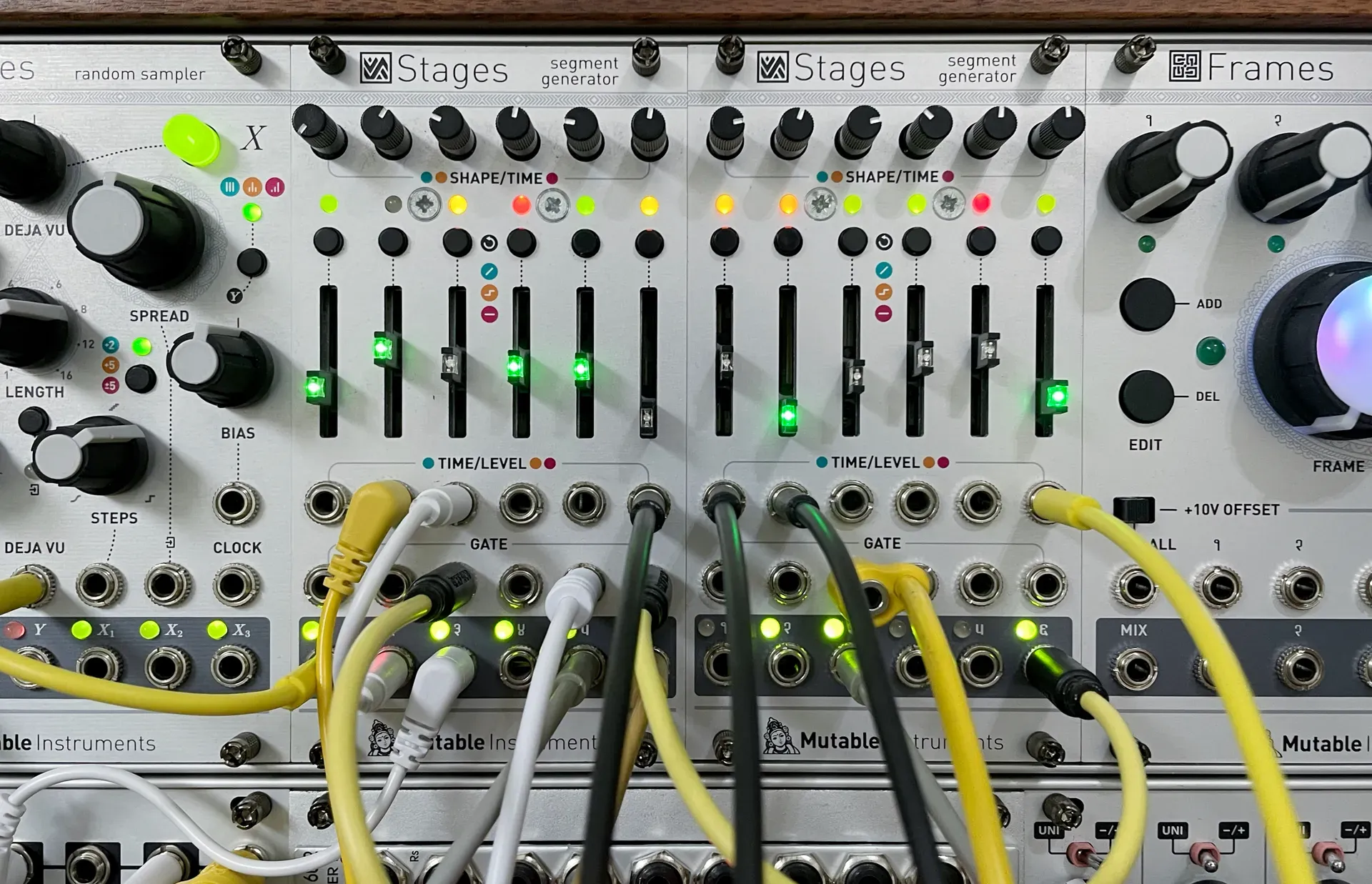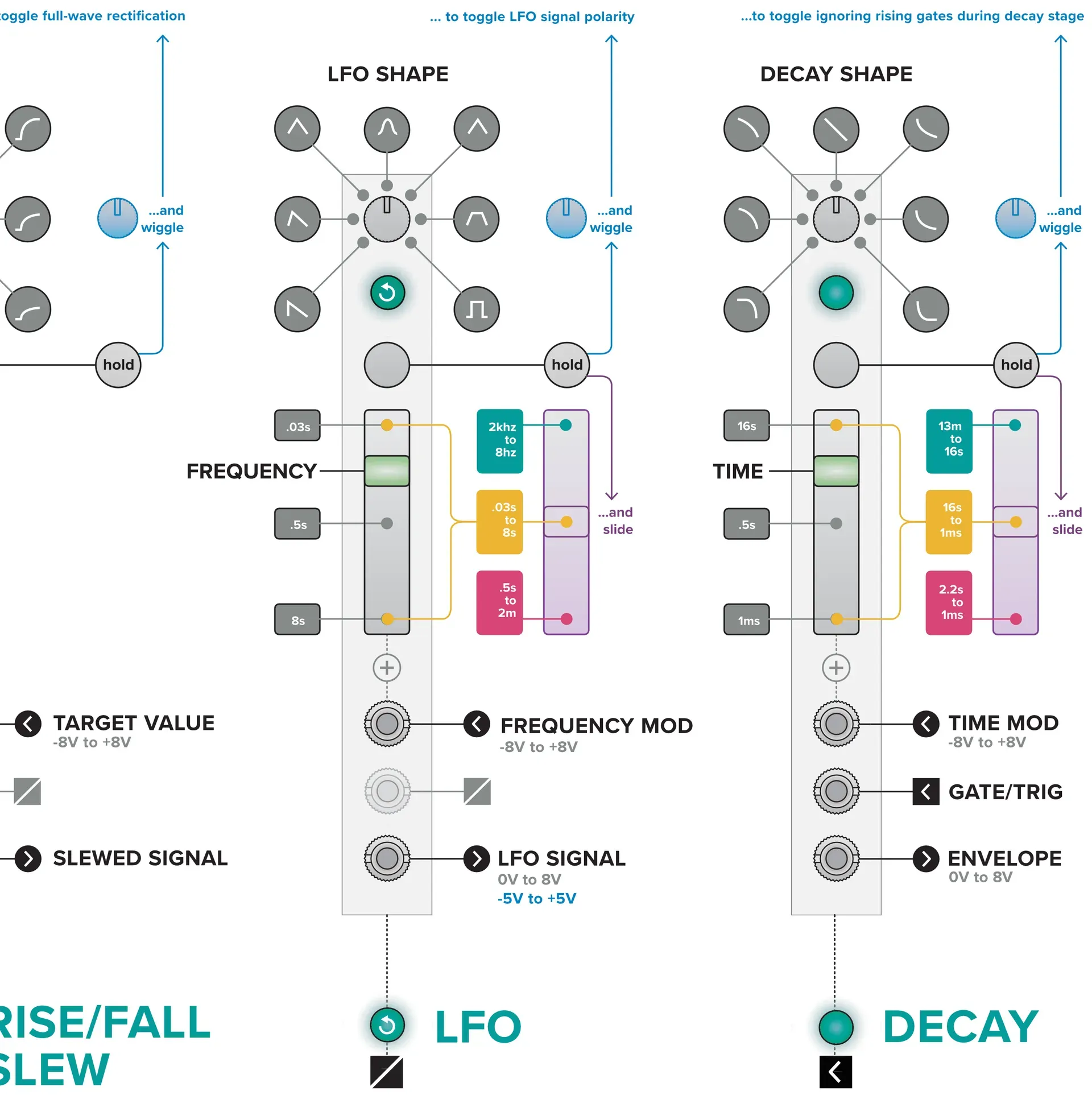Mutable Instruments’ Stages is a curious module. It stands out, even among the thousands of other modules that follow the Eurorack format and enable a synthesiser to be constructed as a collage of individual components.
The defining feature of a modular format is topological flexibility. While a typical synthesiser may offer a considerable set of parameters, its ‘fixed architecture’ still predetermines a particular route through a specific set of components that will successively transform the press of a key into a sound. In contrast, assembling a modular requires choosing exactly which components to employ and using a modular requires choosing exactly how those components are connected. These choices enable signal paths to become desire paths as small pieces are loosely coupled: you can design, or discover, what happens when that specific oscillator is sent to that particular filter when it is controlled by that exact modulator and so on.
Although this flexibility is typically seen in a spaghetti of cables that span between modules, some of the most heralded modules also present their own microcosm of modularity. A function generator like Maths/Falistri, or a sequencer like the 245t/Step 8, are valued because their capabilities can be altered by re-configuring their internal signal paths. Like the broader synthesiser system they act in, these highly patch programmable modules offer a set of building blocks that can construct a range of behaviours.1
Modules that emphasise patch programmability are seemingly distinct to highly modal modules that offer flexible functionality at the press of a button rather than the connection of a cable. An oscillator with distinct modes might be able to dramatically change its underlying model of sound generation; perhaps it switches from summing a set of harmonically related sine waves to instead interpolating between a set of banked waveforms. This capacity to change modes means that a panel’s physical controls are often dynamically mapped: a slider or jack will adapt to control whichever parameters are most relevant to each mode. Highly patch programmable and highly modal modules can both be difficult to use, but untangling the behaviour of the former relies on a more generalised knowledge of synthesis, whereas the latter relies on knowledge that is specific to the individual module.
These two paradigms bring me back to the Stages module. Stages is a great module because it is highly patch programmable. Stages is a difficult module because it is also highly modal. The combination of these two approaches is atypical, or at least usually given lesser emphasis and used to lesser effect. Stages employs both paradigms with a unity of purpose — enabling one or more sequences of voltages to be composed from discrete segments with distinct functions.
This is, admittedly, a pretty abstract job title. Acting as a “complex envelope generator” is a little more concrete. Except, Stages is flexible enough to happily generate six simple envelopes or a pair of three stepped voltages. To blur the line between a sequencer and an envelope generator isn’t uncommon, but Stages goes further with its ability to create adhoc groups of sequences that are each comprised of very different per-step behaviours. Naturally, Stages also has an alternative firmware that multiplies its modality to cover a range of basic utilities and more advanced generative tools.
This all means that Stages has something of a high skill ceiling. It’s easy enough to bootstrap a typical ADSR envelope2 or spin up a bunch of LFOs,3 but more delightful and unusual possibilities often employ extensive patch programming. Exploring these options requires a clear understanding of signal generation as well as a clear understanding of how Stage’s many modes operate.
I made a cheat sheet for Stages while I was learning how I wanted to use it. This shouldn’t be the first thing you read — the official manual or video tutorial are great introductions. But, particularly if working with the alternate firmware, a concise visual reference makes it much easier to begin to memorise how each mode operates and think through what a potential sequence could offer a patch.
Figure .
Figure . A sample from the manual, illustrating two of the green (ramp) segment modes. Blue and purple elements to the right of each segment illustrate interactions specific to the Qiemem firmware that tweak behaviours within a given mode.
This document is also an attempt to try and sketch out a type of manual that I’d like to see more of. Most manuals will provide an overview of the panel, a few key diagrams, and some written explanations of key behaviours. However, these documents — or a YouTube explainer — are clunky to consult in the moment. A more visual map can be quickly parsed. It can also easily illustrate, in-situ, key details like waveforms or voltage ranges, that are often misremembered and would otherwise require an oscilloscope to confirm.
You can download the manual as a pdf here. Feel free to get in touch if you have any suggestions for how to improve it, noting that some of the diagrams for the red/green modes target a yet-unreleased version of the firmware. Stages, and modular synthesis in general, can be explored (for free) in a simulated form using the VCV Rack software.
- To wit: an unofficial Maths patchbook runs 35 pages while Falistri has many hours of tutorial videos.↩
- Best understood as a ‘loudness shape’ that defines how a sound changes over a short period. An envelope might have a quick Attack (akin to the initial strike of a piano key) followed by a Decay to a lower Sustained plateau (like using a sustain pedal) before being Released and fading to silence.↩
- A “low frequency oscillator”, or repeating waveform that is typically inaudible and instead used to affect an audible signal by controlling a parameter. E.g. an LFO controlling an amplifier could modulate volume to create tremolo while an LFO connected to a pitch input could modulate frequency to create vibrato.↩

